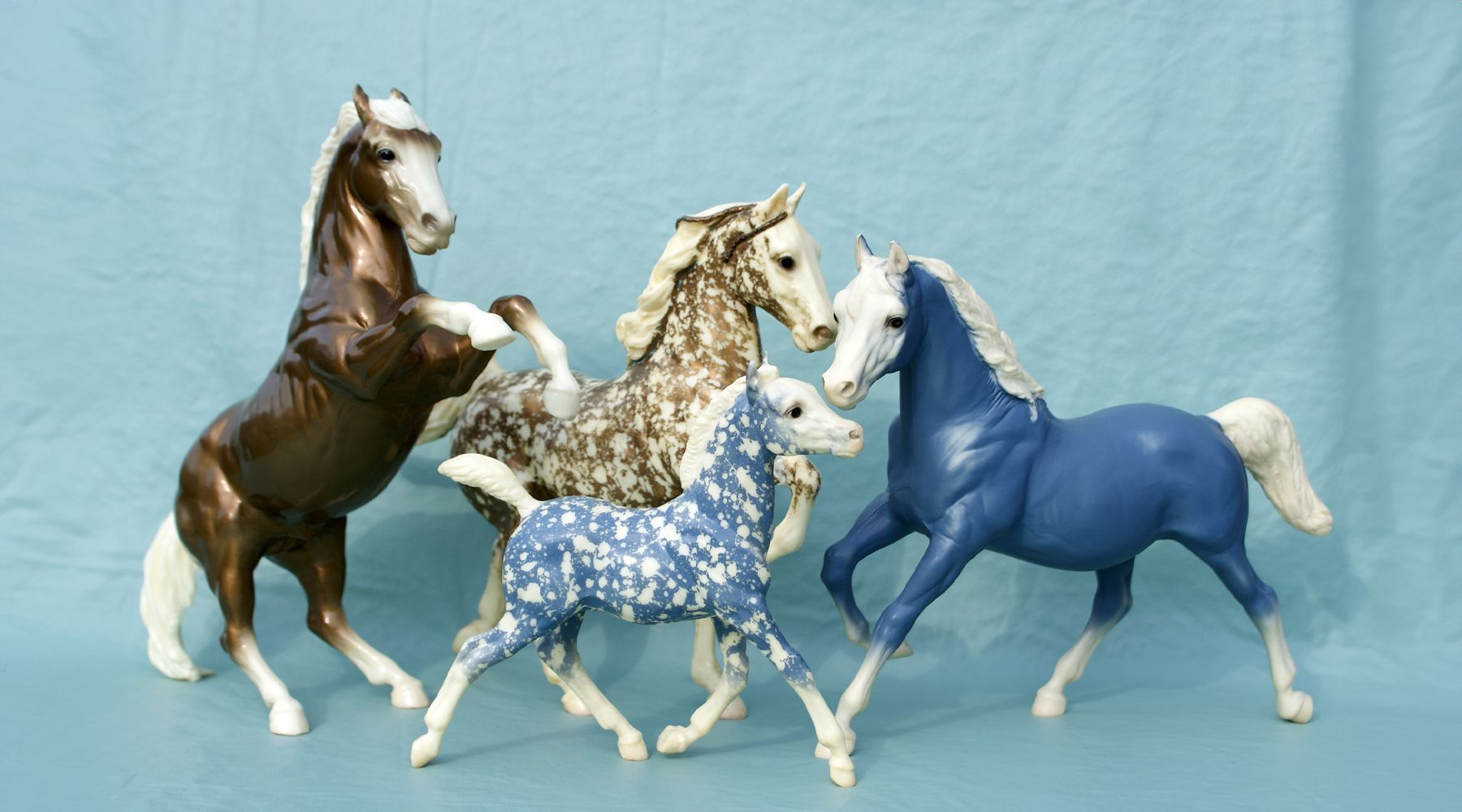
Where to Find Breyer This Holiday Season
A guide to nearly 100 physical retailers across 39 states!


Fighting Stallions
Courtesy of Kirsten Wellman
 |
|
Charcoal Fighting Stallion & Running Stallion |
New hobbyists are often known to pose the age-old Breyer question: "What exactly is charcoal?" Well, it's a color that is pretty much uniquely Breyer, and quite in demand on older models!
There is no solid real horse color explanation for charcoal - black or brown/black with white points, often with a heavy gloss, first introduced on the Family Arabian Stallion mold in the early 60s - but there's no disputing its popularity. Often with gorgeous highlights on the face, shoulders and flank, pinking on the nose, ears and hooves and a rich gloss, charcoal is ever in demand on the Running Stallion, Fighting Stallion and Semi-Rearing Mustang, to name a few. When eyewhites are present, these models are spectacular!
Also creating quite a stir among model collectors is glossy grey Appaloosa - stunning on the Fighting Stallion and the Mustang. The grey color varies from true grey to a brownish tone. The Fighting Stallion and Family Arabians sport dark points, and the Arabians in particular may have a distinctly whiter barrel with grey fore- and rear-quarters. Their spots are black. The Mustang displays white points, and his spots are often large with a concentration on the hips. However, the rarer and sometimes more desirable variation on the Mustang and Fighting Stallion is fine spotting across the back to the shoulders.
Many glossy grey Appaloosas may also display eyewhites, an added attraction found on models from the 1960s. The Proud Arabian Mare and Foal are both as lovely as they are rare in this vintage coloration.
 |
 |
|
Glossy Grey Appaloosas |
Appaloosa Proud Arabian Mare and Foal Courtesy of Kirsten Wellman |
The '60s also gave life to another unusual color: old style red roan. Wildly spotted reddish-brown with dark points, the red roan is appealing and always treasured on the Lying and Scratching Foals, Running Stallion, Running Mare and special run Running Foal. This color was given a matte finish and may vary from light to dark.
 |
 |
|
Red Roan Lying Foal
Courtesy of Sara Roche |
Red Roan Running Stallion
Courtesy of Kelly Weimer |
Woodgrain also varies from light to dark, and is one of the most remarkable Breyer colors ever produced. First introduced around 1959, well-painted woodgrains have a very smooth semi-glossy grain finish, with excellent and clever color, giving them the look of a wood-carved piece. Over twenty different molds were afforded this color, including Breyer livestock and dogs.
Some woodgrains are relatively easy to find, such as the Family Arabians. The Belgian, Morgan, and Proud Arabian Mare and Foal molds are several of the more difficult molds to acquire in the woodgrain finish.
 |
 |
|
Group of Woodgrains |
Woodgrain Family Arabian Mare |
The Running Mare and Foal came in an unusual but lovely version of glossy dapple grey. The white dapples were concentrated on the hips, giving the illusion of an appaloosa. The finest pieces are heavily glossed and often look like porcelain. Many display delicate and detailed pinking on the face.

Glossy Grey Appaloosa Running Mare and Foal
The Running Mare and Foal also came in a distinctive smoke color, with their matte coats a smoky grey with white points. This striking color was also given to the Western Prancing Horse and the Belgian and is not very easy to find.

Glossy alabaster "albino" is a color unique to the Semi-Rearing Mustang and the Five Gaiter. Red-brown eyes, some grey muscle shading and a wet-looking gloss characterize these wonderful fellows. Several other models with black eyes have been produced in the glossy alabaster coloration, such as the Fighting Stallion.

Albino Semi-Rearing Mustang
Courtesy of Sara Roche
The decorators are Breyer's most unusual colors. Only available from approximately 1963 to 1964, these fantasy colors were not popular with the model horse-buying public at the time. That is why they are so hard to find today! All decorators have white points with face and hoof pinking. Glossy models include Gold Charm, a solid gold with white points, Florentine, a wildly dappled gold and Copenhagen, a wildly dappled blue. Wedgewood, a solid blue, was the only matte decorator color produced on these five different molds.

All four decorator colors!
Courtesy of Kelly Weimer
The Breyer palate of collectible colors also includes many beautifully-painted, realistic colors. These old styles, however, wax nostalgic of another era: of Breyer's earliest years of horsing around. They are unique and fun to discover at flea markets, antique stores and even in grandma's attic, so enjoy and happy hunting!

A guide to nearly 100 physical retailers across 39 states!

A collection of exclusive models is now arriving at Tractor Supply stores just in time for the holiday season!

We're making room for exciting new 2026 additions!
